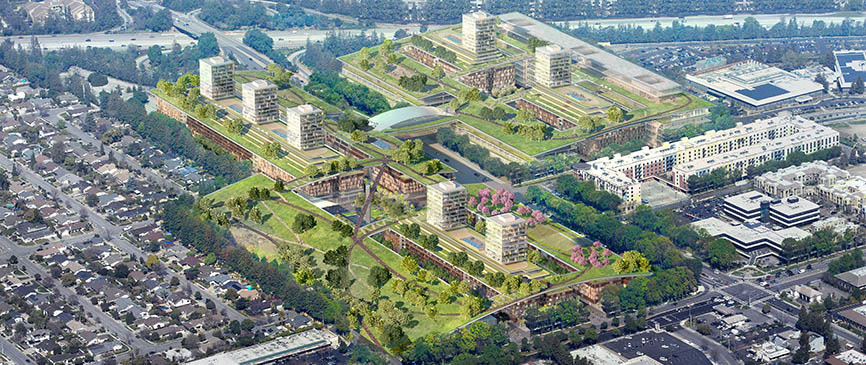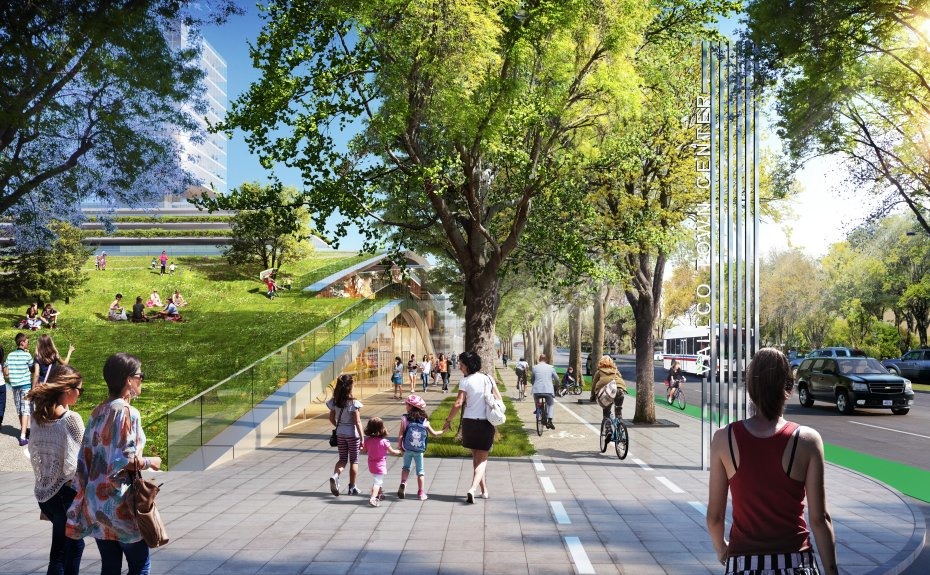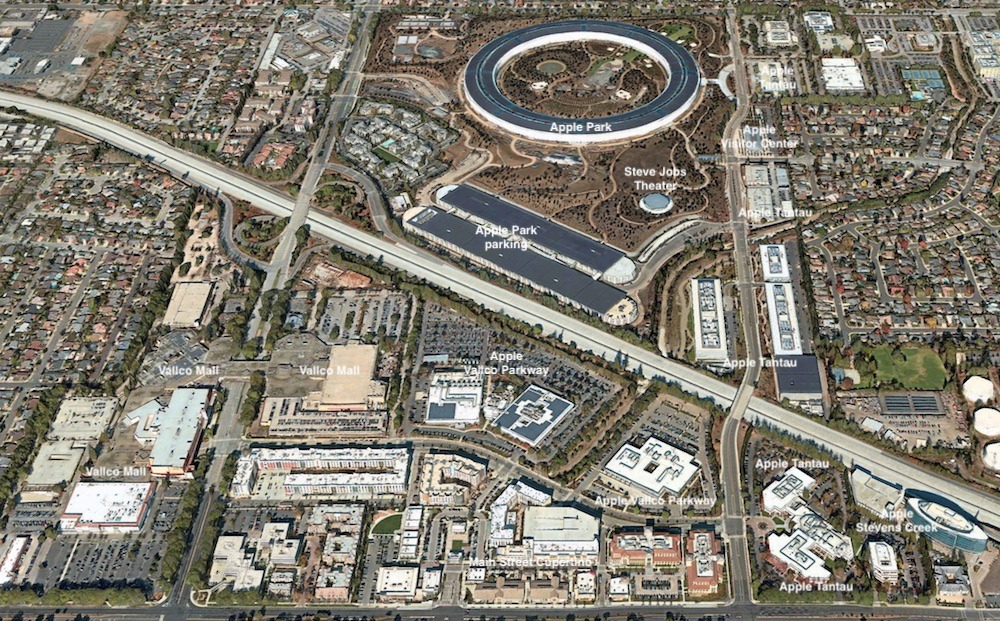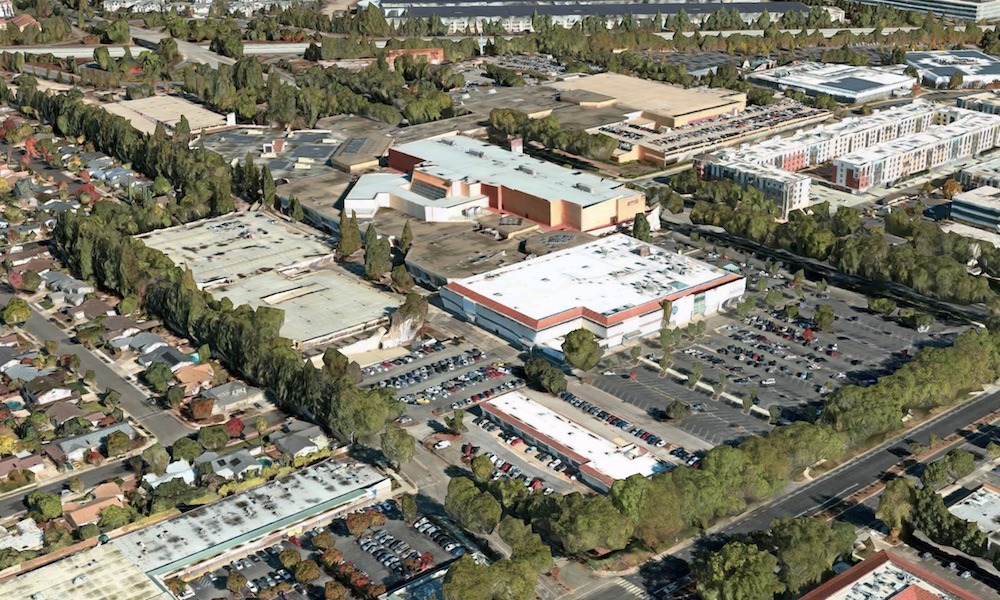A dead shopping mall next to Apple Park has been fighting to reinvent itself as a mix of retail, offices and new housing for years, only to be blindsided by NIMBY groups seeking to protect high housing prices. A new state law, however, promises to streamline approval enable the market to solve California's dire housing shortage.
A proposal by developer Sand Hill Property Co. to revamp the old Vallco Shopping Mall site— located next to Apple's Vallco Parkway and its other offices around Apple Park— has been languishing in its planning stages for four years.
Cupertino's government has generally frowned at building any new housing (during a severe shortage of places to live in the region) because it gets more tax revenue from office space. Apple's local taxes alone fund around 30 percent of the town's budget.
However, new SB 35 legislation written by California state Senator Scott Wiener of San Francisco now enables a faster, simplified approval process for projects that are zoning-compliant and provide for at least 50 percent of their housing units to qualify as affordable.
"We need more housing now, and we spent 50 years erecting obstacle after obstacle to housing. We need to remove those obstacles," Wiener was cited as saying in a report by the SF Chronicle.
Sand Hill Property has taken advantage of the new law to file an application to build 2,400 housing units at the site, which will not need City Council approval, along with 1.8 million square feet of office space and 400,000 square feet of retail, as part of its Vallco Town Center plan.
 Vallco Town Center rendering. Source: Sand Hill Property Co.
Vallco Town Center rendering. Source: Sand Hill Property Co.Given that Apple has been snapping up all the office space it can in Cupertino (including new buildings recently built between the mall and Apple Park) it's likely that the company might express interest in occupying major new office space within walking distance of its new campus, as well as offices at 1 Infinite Loop.
Apple and the Mall
Vallco Mall and its sprawling parking lots sit next to a series of Apple's existing Vallco Parkway offices, including new space the company now leases next to the recently built "Main Street Cupertino" project, which actually does involve both new offices and some housing.
The large indoor mall, which bridges over Wolfe Road, is about as old as Apple itself: built in 1976 as Americans were fleeing the cities to pave over surrounding farmlands in order to build out the sprawl of suburbia.
This move created the Petri dish of Silicon Valley, where kids like Steve Jobs and Steve Wozniak were raised in safe communities of middle-class families, with the ability to pursue their curiosities— taking advantage of specialized technical education and job opportunities at the region's founding technology firms, including Atari and Hewlett Packard (the latter of which paved over the orchards and occupied the land where Apple Park now sits) and even found their own new companies.
In the mid-80s, Vallco Mall, originally called "Vallco Fashion Park," began facing new competition from more modern shopping centers. Like Apple itself, the mall attempted to refresh and expand itself to remain competitive. However, in the 1990s it was hit by a series of forces, including the emerging role of online retailers and the fact that increasingly affluent demographics in Silicon Valley weren't attracted to its midrange tenants.
In 2007, as Apple released the iPhone, Vallco Mall added a new 16 screen theater and a bowling alley. By 2015, the decline of retail prompted its owners to come up with new plans to demolish the entire thing and rebuilt a modern mix of shopping, offices and housing on a street grid covered with green parks, orchards and gardens.
The project was called The Hills of Vallco. The planning site (portrayed in a rendering below) would be directly opposite from Apple Park's garages (top of the image) and across the street from the company's Vallco Parkway 2A building (top right).
However, homeowners concerned that any new housing might affect the stratospheric valuation of their own property (in a city where a standard family home is priced in the millions) rushed to kill plans for any new housing. Two competing measures, one to block the construction of anything on the site apart from retail, and another to push through the original The Hills of Vallco plan without the risk of it being derailed by opponents leveraging the city planning process, both failed to pass in 2016.
 Vallco Town Center rendering. Source: Sand Hill Property Co.
Vallco Town Center rendering. Source: Sand Hill Property Co.In the year since, things have only gotten worse for Vallco Mall as its large anchor stores (formerly Sears, Macy's and JC Penney) remained abandoned and its interior walkways lead to little more than empty retail stores and a few random low-rent tenants. Its owners have announced that they have no interest in trying to spruce up the site because it demands a larger investment to create something new.
Homeowners are still trying to block any new housing, asking that the old mall only be replaced by a new shopping center, despite the fact that there is clearly no real demand for a shopping center in Cupertino.
At this point, Vallco could probably best serve as an opportunity for Apple to take over the property and use it for expansion of its existing Vallco offices. But housing advocates are asking Apple's workers— most of whom can't afford to buy housing in Cupertino even with professional salary— to push for new housing on the site. At the currently insane housing prices of Silicon Valley, a couple of Apple employees trying to buy a house in Cupertino would face a mortgage of around $10,000 per month
At the currently insane housing prices of Silicon Valley, a couple of Apple employees trying to buy a house in Cupertino would face a 20 percent down payment on an existing home at a price even higher than greater SV's median of $1.17 million, meaning they'd also have to pay a mortgage of around $10,000 per month. And there are only a couple dozen available houses for Apple's thousands of employees to even attempt to buy anywhere near the company's offices.
That prompts much of Apple's workforce to commute from more affordable (or at least more desirable) areas, including San Francisco, around 40 minutes away when there isn't any traffic. Apple has worked to develop a network of buses to minimize the impact of traffic because the Bay Area suburbs lack much effective transit of their own.
Some residents in desirable areas of San Francisco served by buses from Apple (and other firms in a similar predicament, including Google) have demonized the influx of new workers as a gentrifying force, as if the City would be better off in an economic decline, with the kind of violent crime and decay that San Francisco limped through in previous decades of lower rents.
San Francisco also faces a long-term housing shortage, in part because activists there, as in Cupertino, work to block the development of any new housing (particularly any housing density), fearing that any new housing would be filled with some sort of undesirables.
While no panacea, the redevelopment of Vallco Mall as a place for people to live, work and shop could at least help reduce the need for long-distance commuting and further shifts that displace people and raise rents elsewhere.
 Daniel Eran Dilger
Daniel Eran Dilger








-m.jpg)






 Charles Martin
Charles Martin
 Marko Zivkovic
Marko Zivkovic
 Andrew Orr
Andrew Orr
 Amber Neely
Amber Neely

 William Gallagher and Mike Wuerthele
William Gallagher and Mike Wuerthele











22 Comments
Affordable in Cupertino? LOL. It doesn't matter. They can sell the house at 20% cheaper and no one would be able to afford it. Why don't they just do thing like San Jose before: co-investment in the properties in which City will fund 40% of the house price for 1st time home buyers as "silence loan" and owners will pay it back when the house is sold splitting the gain? It was such a good program and many SJ residents bought their 1st home that way.
Interesting alternate reality perspective on the cause of the housing shortage in the Bay Area. The actual reason, is of course rent control. Unsurprisingly developers seems disinclined to build housing and then be forced to rent it for a loss.
50% affordable is a better goal than is typical in many cities around the country. Not sure about those giant sloped lawn areas in drought-stricken CA though. They probably need to add quite a bit more drought resistant landscaping and axe a lot of the lawn.
The Silicon Valley, needs high rise living, but they will not do that for a couple of reasons, first they do not want the skyline blinders, second they have to deal with earthquakes.
I feel bad for those who spend most of their income of housing and the situation will not get better.